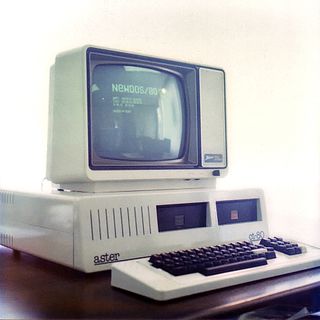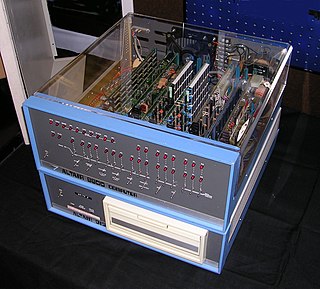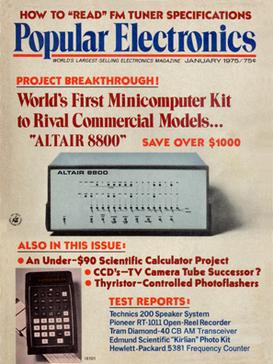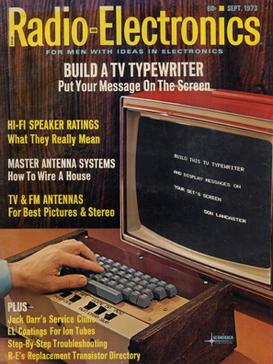
The Aster CT-80 is a 1982 personal computer developed by the small Dutch company MCP, was sold in its first incarnation as a kit for hobbyists. Later it was sold ready to use. It consisted of several Eurocard PCB's with DIN 41612 connectors, and a backplane all based on a 19-inch rack configuration. It was the first commercially available Dutch personal/home computer. The Aster computer could use the software written for the popular Tandy TRS-80 computer while fixing many of the problems of that computer, but it could also run CP/M software, with a large amount of free memory Transient Program Area, (TPA) and a full 80×25 display, and it could be used as a Videotext terminal. Although the Aster was a clone of the TRS-80 Model I it was in fact more compatible with the TRS-80 Model III and ran all the software of these systems including games. It also had a built-in speaker which was compatible with such games software.

The Sinclair ZX80 is a home computer launched on 29 January 1980 by Science of Cambridge Ltd.. It is notable for being one of the first computers available in the United Kingdom for less than a hundred pounds. It was available in kit form for £79.95, where purchasers had to assemble and solder it together, and as a ready-built version at £99.95.

The KIM-1, short for Keyboard Input Monitor, is a small 6502-based single-board computer developed and produced by MOS Technology, Inc. and launched in 1976. It was very successful in that period, due to its low price and easy-access expandability.

The Homebrew Computer Club was an early computer hobbyist group in Menlo Park, California, which met from March 1975 to December 1986. The club had an influential role in the development of the microcomputer revolution and the rise of that aspect of the Silicon Valley information technology industrial complex.

The Altair 8800 is a microcomputer designed in 1974 by MITS and based on the Intel 8080 CPU. Interest grew quickly after it was featured on the cover of the January 1975 issue of Popular Electronics and was sold by mail order through advertisements there, in Radio-Electronics, and in other hobbyist magazines. According to Harry Garland, the Altair 8800 was the product that catalyzed the microcomputer revolution of the 1970s. It was the first commercially successful personal computer. The computer bus designed for the Altair was to become a de facto standard in the form of the S-100 bus, and the first programming language for the machine was Microsoft's founding product, Altair BASIC.

The S-100 bus or Altair bus, IEEE 696-1983(withdrawn), is an early computer bus designed in 1974 as a part of the Altair 8800. The S-100 bus was the first industry standard expansion bus for the microcomputer industry. S-100 computers, consisting of processor and peripheral cards, were produced by a number of manufacturers. The S-100 bus formed the basis for homebrew computers whose builders implemented drivers for CP/M and MP/M. These S-100 microcomputers ran the gamut from hobbyist toy to small business workstation and were common in early home computers until the advent of the IBM PC.

The Kansas City standard (KCS), or Byte standard, is a data storage protocol for standard cassette tapes at 300 bits per second. It originated in a symposium sponsored by Byte magazine in November 1975 in Kansas City, Missouri to develop a standard for the storage of digital microcomputer data on inexpensive consumer quality cassettes. The first systems based on the standard appeared in 1976.
"An Open Letter to Hobbyists" is a 1976 open letter written by Bill Gates, the co-founder of Microsoft, to early personal computer hobbyists, in which Gates expresses dismay at the rampant software piracy taking place in the hobbyist community, particularly with regard to his company's software.
Micro Instrumentation and Telemetry Systems (MITS) was an American electronics company founded in Albuquerque, New Mexico that began manufacturing electronic calculators in 1971 and personal computers in 1975.

Popular Electronics was an American magazine published by John August Media, LLC, and hosted at TechnicaCuriosa.com. The magazine was started by Ziff-Davis Publishing Company in October 1954 for electronics hobbyists and experimenters. It soon became the "World's Largest-Selling Electronics Magazine". In April 1957, Ziff-Davis reported an average net paid circulation of 240,151 copies. Popular Electronics was published until October 1982 when, in November 1982, Ziff-Davis launched a successor magazine, Computers & Electronics. During its last year of publication by Ziff-Davis, Popular Electronics reported an average monthly circulation of 409,344 copies. The title was sold to Gernsback Publications, and their Hands-On Electronics magazine was renamed to Popular Electronics in February 1989, and published until December 1999. The Popular Electronics trademark was then acquired by John August Media, who revived the magazine, the digital edition of which is hosted at TechnicaCuriosa.com, along with sister titles, Mechanix Illustrated and Popular Astronomy.

Lee Felsenstein is an American computer engineer who played a central role in the development of personal computers. He was one of the original members of the Homebrew Computer Club and the designer of the Osborne 1, the first mass-produced portable computer.

Processor Technology Corporation was a personal computer company founded in April 1975, by Gary Ingram and Bob Marsh in Berkeley, California. Their first product was a 4K byte RAM board that was compatible with the MITS Altair 8800 computer but more reliable than the MITS board. This was followed by a series of memory and I/O boards including a video display module.

The TV Typewriter is a video terminal that could display two pages of 16 lines of 32 upper case characters on a standard television set. The design, by Don Lancaster, appeared on the cover of Radio-Electronics magazine in September 1973.

The Sol-20 was the first fully assembled microcomputer with a built-in keyboard and television output, what would later be known as a home computer. The design was the integration of an Intel 8080-based motherboard, a VDM-1 graphics card, the 3P+S I/O card to drive a keyboard, and circuitry to connect to a cassette deck for program storage. Additional expansion was available via five S-100 bus slots inside the machine. It also included swappable ROMs that the manufacturer called 'personality modules', containing a rudimentary operating system.

The Cromemco Dazzler was a graphics card for S-100 bus computers introduced in a Popular Electronics cover story in 1976. It was the first color graphics card available for microcomputers. The Dazzler was the first of a succession of increasingly capable graphics products from Cromemco which, by 1984, were in use at 80% of all television stations in the U.S. for the display of weather, news, and sports graphics.

The Pennywhistle was an early acoustic coupler modem originally designed and built by Lee Felsenstein in 1973, and later commercialized and offered for sale in 1976. It was one of the earliest modems available for hobbyist computer users. Like most acoustic coupler modems, the Pennywhistle was replaced by the Hayes Smartmodem and similar models from the early 1980s.
PolyMorphic Systems was a manufacturer of microcomputer boards and systems based on the S-100 bus. Their products included the Poly-88 and the System 8813. The company was incorporated in California in 1976 as Interactive Products Corporation d/b/a PolyMorphic Systems. It was initially based in Goleta, then Santa Barbara, California.
Trek-80 is a text-based video game written by Steve Dompier in 1976 and sold by Processor Technology for their Sol-20 computer and suitable S-100 bus machines.
The 3P+S Input/Output Module was an S-100 expansion card introduced to the microcomputer market by Processor Technology. It supplied three parallel ports and one serial port, the latter of which conformed to the RS-232C standard. One of the three parallel ports was dedicated to interfacing with the host computer over the S-100 bus, while the other two were available for general use.
The Micro Expander Model 1 is an S-100-based microcomputer introduced by Micro-Expander, Inc., in 1981. The computer was the brainchild of Lee Felsenstein, designer of the Sol-20, the first home computer. After his primary client and marketers of the Sol-20, Processor Technology, went out of business in 1979, Felsenstein founded a new company, Micro-Expander, Inc., in 1980. He gained the capital to sell his prototype of a successor to the Sol-20 as the Micro Expander Model 1 with help from some Swedish investors, primarily Mats Ingemanson, who was hired to market the computer.















